Being faced with the question “How long can a dog live with hip dysplasia?” is difficult. But help is here! Rehabilitation veterinarian Dr. Angela Youello gives a brief overview of hip dysplasia. Then she provides an in-depth perspective on how to give your hip dysplasia dog the best possible quality of life and walks you through knowing when it is time to say goodbye.
If your beloved pup has been diagnosed with canine hip dysplasia, you probably have a lot of questions. Can he or she still live a normal life? What can you do to help him or her? How long can a dog live with hip dysplasia anyway?
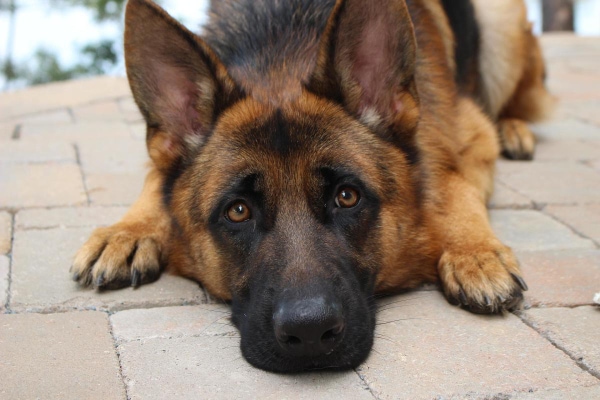
We will get to the answers to those questions. But to start, let’s clarify what hip dysplasia actually is. It’s a term we hear a lot, but it’s not always clearly defined.
- What is hip dysplasia?
- What are the signs of hip dysplasia in dogs?
- How is hip dysplasia diagnosed?
- How long can a dog live with hip dysplasia?
- How can I help my dog with hip dysplasia live longer and more comfortably?
- What is the outlook for dogs with hip dysplasia?
- How well can a dog live with hip dysplasia?
- What helped your dog with hip dysplasia keep living his or her best life?
What is hip dysplasia?
Dysplasia simply means abnormal growth and development. Therefore, hip dysplasia occurs when the hip joint, where the leg attaches to the pelvis, doesn’t develop normally.
A normal hip joint is a ball and socket joint. The ball (i.e. head of the femur) is held tightly in the socket (i.e. acetabulum of the pelvis) and is only able to move by rotation. In a dog with hip dysplasia, the socket is too shallow and doesn’t tightly hold the head of the femur. This allows abnormal movement in the joint. Over time, this abnormal movement causes wearing away of the cartilage in the hip joint, eventually leading to osteoarthritis in dogs.
Causes of hip dysplasia
Hip dysplasia is a congenital condition, meaning that dogs are born with it. There is a strong genetic component, with multiple genes being implicated in the development of the disease. Some breeds are very prone to hip dysplasia while others are rarely affected. The more commonly affected breeds include:
- Bulldogs
- Mastiffs
- German Shepherds
- St Bernards
Since the underlying cause of hip dysplasia in dogs is genetic, the best way to prevent hip dysplasia is careful and responsible breeding. This is important to ensure the genes associated with hip dysplasia are not passed down to new generations of dogs.
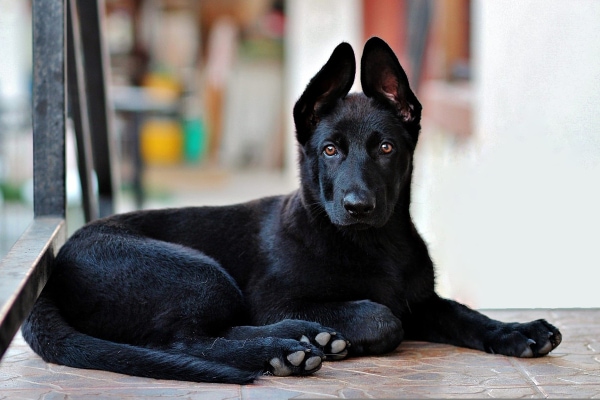
Factors that influence the development of hip dysplasia
If your dog is already part of the family, there isn’t much you can do about his or her genetics. But thankfully, genetics aren’t the only thing that dictate the course of hip dysplasia.
There are also several environmental factors that can influence when dogs start to develop clinical signs, and how serious their symptoms will be. The two biggest contributors are body weight and age at time of spay/neuter. The good news here is that you often do have control over those factors.
Body weight
Rapid weight gain during growth, and being overweight as an adult, are two important risk factors for arthritis associated with hip dysplasia in dogs.
A study published in the Journal of the American Veterinary Medical Association (JAVMA) looked at the association between body weight and development of arthritis in Labrador Retriever littermates. The researchers determined that dogs who were free fed (i.e. allowed to eat as much as they wanted) developed arthritic changes on X-rays at an average of 6 years old. On the other hand, littermates fed a diet containing 25% fewer calories did not develop signs of arthritis until an average of 12 years old!
This is just one of the many reasons it is so important to keep your dog at a healthy weight. If you are wondering, “Is my dog overweight?” please talk to your vet now. Don’t wait until your dog starts to develop orthopedic issues.
Age at time of spay or neuter
Spayed and neutered dogs are more likely than intact dogs to develop hip dysplasia. Some of this may relate to the higher risk of spayed and neutered dogs being overweight, which we know is a risk factor for hip dysplasia and arthritis.
Additionally, several studies have found that early spaying and neutering (i.e. before full adult growth is reached) delays closure of growth plates. This leads to biomechanical changes that can increase the risk of orthopedic injuries in adulthood. In one study, Golden Retrievers neutered before 12 months of age were twice as likely to develop hip dysplasia as intact males.
Your veterinarian is the best person to advise you about when to spay or neuter your dog. There are a variety of health, behavior, and size factors that go into determining the timing of spay or neuter so there isn’t one right answer across the board.

What are the signs of hip dysplasia in dogs?
These three factors—genetics, body weight, and timing of the spay/neuter—all play a role in the symptoms a dog may exhibit. Some dogs with hip dysplasia don’t have any obvious symptoms. But most have some changes that point to hip dysplasia. Common signs of hip dysplasia you may notice at home include:
- A bunny-hopping gait (i.e. moving both back legs together as a unit instead of alternating them)
- Limping or lameness that gets worse following vigorous activity
- Limping first thing in the morning, which often improves with gentle activity
- Trouble getting up from laying down
- Difficulty going up stairs
- Stiffness, especially when first getting up in the morning or after a long nap
- Decreased muscle mass in the back legs compared to the front legs
- Reluctance to run or jump
- Narrow hind leg stance (standing with rear legs close together)
Dogs who begin to show symptoms of hip dysplasia tend to fall into two distinct age groups— puppies and young dogs (usually 6 months old to 3 years old) or middle-aged to older dogs (over 7 years old). The symptoms and diagnostic process look different depending on the dog’s age.
How is hip dysplasia diagnosed?
Affected puppies or young dogs usually have significant looseness (i.e. laxity) in their hip joints. But they have not yet developed arthritic changes. Often you will see a bunny-hopping gait and sometimes reluctance to go up stairs. However, you usually don’t see other obvious symptoms in this age group.
In fact, hip dysplasia may be an incidental finding in some young dogs. In those cases, the dog may not be having any issues at home, but the veterinarian detects some hip laxity during the physical exam.
As part of the diagnostic process, the vet may check for the Ortolani sign. This involves first trying to gently move the head of the femur slightly out of the hip socket. Then the vet will feel for a characteristic pop or clunk as the head of the femur moves back into the acetabulum. If the Ortolani sign is present (i.e. the vet can move the head of the femur in and out of the socket), the dog has hip laxity. This is very suggestive of hip dysplasia.
On the other hand, the older dogs with hip dysplasia tend to exhibit signs of arthritis in dogs. Hip dysplasia usually shows up on a vet’s radar when the dog develops lameness after activity (or conversely after rest), decreased interest in walks, or loss of muscle mass in the back legs.
These dogs often have decreased hip extension on the physical exam. In other words, they resist when the vet tries to move their hind leg into normal extension because this motion causes discomfort. This often prompts the vet to recommend hip X-rays, which are the gold standard for hip dysplasia diagnosis in dogs.
X-rays
On X-rays, dogs with normal hips will have a deep acetabulum (i.e. hip socket) and round femoral head. These two components will fit tightly together. Dogs with dysplastic hips have a shallower hip socket, a misshapen femoral head that does not fit tightly in the socket, or both. Also, older dogs with hip dysplasia will often have arthritic changes visible on their X-rays.
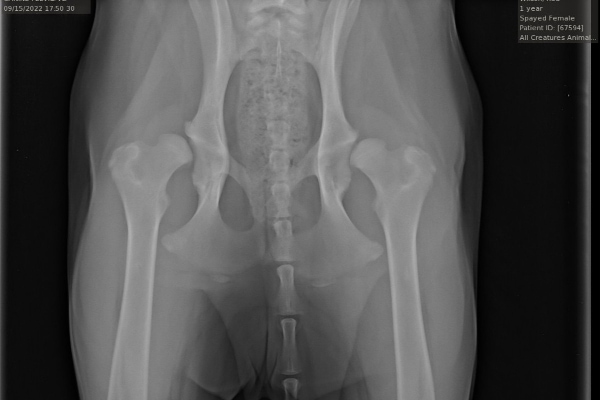
For most companion dogs, simple X-rays of the hips are enough to evaluate the hips and reach a diagnosis of hip dysplasia. However, there are some situations (such as selection of dogs for breeding) where your vet may recommend using one of the standardized systems for evaluating hips for possible dysplasia.
Some of the most popular options are the Orthopedic Foundation for Animals (OFA), PennHIP, and the British Veterinary Association/Kennel Club. These organizations provide detailed guidelines for positioning of patients for X-rays as well as guidance on using standardized criteria to grade the severity of the hip dysplasia.
How long can a dog live with hip dysplasia?
Once your dog is diagnosed with hip dysplasia, you and your veterinarian can make a plan to keep your dog as mobile and comfortable as possible for as long as possible. As part of that, your vet can start to address the question that is probably weighing on your mind—How long can a dog live with hip dysplasia?
The answer to this question depends on a lot of individual factors that may be different for every dog. This is why it is important to discuss this with your vet since he or she knows your dog. But the good news is that many dogs with hip dysplasia will have a normal life expectancy! With early diagnosis and proactive care, dogs with hip dysplasia can often live as long as their non-dysplastic counterparts.
How can I help my dog with hip dysplasia live longer and more comfortably?
There are so many options now for management of hip dysplasia. Plus, you can make a variety of lifestyle or environmental changes to keep your dog’s hips as functional and pain-free as possible. The sooner you can start, the more impact you can have. So let’s dive into seven ways to help your dog with hip dysplasia.
1. Keep your dog at an ideal body weight (or help him or her get there).
Weight management is perhaps the most important factor you can change to positively impact your dog’s quality of life. Multiple studies have shown that even modest weight loss (2 to 6% of total body weight, which would be about 1 to 3 pounds of weight loss for a 50 pound dog) significantly decreases lameness in dogs with hip dysplasia and arthritis.
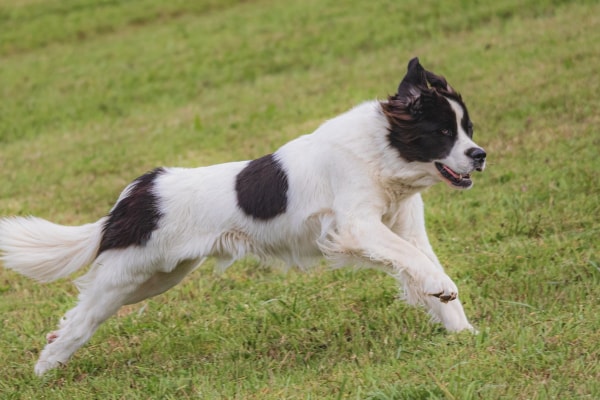
It makes sense that with increased body weight, each step taken places increased stress on your dog’s joints. Therefore, helping your dog maintain a healthy weight can dramatically reduce that strain. If you’re concerned about your dog’s weight, here are a few helpful suggestions:
- Learn how to find your dog’s body condition score (BCS).. Then continue to assess your dog’s BCS on a regular basis so you can keep your dog at a steady and ideal weight.
- Read Dr. Buzby’s article on how to help your dog lose weight
- Ask your dog’s veterinary team to help you create a customized weight management or weight loss plan for your dog
2. Partner with a rehabilitation professional.
Physical rehabilitation (similar to physical therapy in humans) is another wonderful tool for helping manage your dog’s hip dysplasia. It can help improve his or her quality of life and life expectancy!
Almost all dogs can benefit in some way from rehabilitation, from puppies right up through very elderly senior dogs. In puppies, the rehab professional might focus more on building muscle strength and muscle mass to support the hips. This can help reduce abnormal motion in the hip joint that can lead to arthritis.
In older dogs the rehab vet will often concentrate on relieving pain associated with arthritis. Plus, he or she might work on maintaining normal range of motion in affected joints and slowing down the rate of age-related muscle loss.
Rehab can offer many different ways to help your dog be stronger and more comfortable, including:
- Laser therapy for dogs to reduce joint pain and inflammation
- Massage and joint mobilizations to help arthritic joints be able to move more easily
- Underwater treadmill therapy for dogs to provide low-impact exercise for dogs who may be too sore to go for long walks on land
- Specialized home exercises to help work on strength and mobility between rehab visits.
These things can all help dogs enjoy a better quality of life, which in turn can extend their life expectancy following a diagnosis of hip dysplasia. To illustrate the benefits of rehab, allow me to introduce you to two of my patients:
Meet Vera

Several years ago I worked with a mastiff puppy named Vera who had been diagnosed with hip dysplasia. Because she was a giant breed dog, her parents were advised to consider surgery. However, they wanted to avoid it if possible, so they brought her to see me for physical rehabilitation.
Her program focused on maintaining her at a very lean body weight and building muscle strength. We accomplished this through the use of regular walks at home, specific exercises designed to strengthen the muscles supporting her hips and core, and regular underwater treadmill workouts to provide resistance to further strengthen her leg and core muscles.
When I last saw Vera she was 4 years old and had no clinical signs of hip dysplasia. She was able to participate in all the activities she enjoyed, and no one observing her would ever know she wasn’t a completely normal dog!
Meet Minnie
More recently, I treated an older Labrador Retriever named Minnie. She came to see me because she had developed arthritis secondary to her hip dysplasia. Minnie was having trouble getting up onto the couch, using the stairs, and going for her daily walks. She even had a hard time getting up from her bed first thing in the morning. And because she was a large dog, it was difficult for her owners to assist her.
For Minnie, we started with laser therapy, massage, and manual therapy such as joint mobilizations to relieve joint pain and muscle stiffness. When she started to feel a little better, we began short underwater treadmill sessions. Plus, I taught her parents some gentle home exercises to help maintain muscle strength and improve balance and core strength. We also fitted her for a Help ‘Em Up harness (more on those soon), which enabled her owners to assist her in a way that was physically easier for them.
Watching her regain some of her ability to move around her home the way she wanted to was wonderful. Her hard work in rehab certainly improved her quality of life. It also made life easier for her owners, who no longer had to bend over to hoist her out of bed in the morning!
3. Give your dog the gift of traction.
Ensuring access to good, secure footing is very important for any dog. But it is especially necessary for dogs with hip dysplasia or arthritis. Injuries from slipping on hardwood or tile floors are common in dogs with orthopedic issues. And dogs with hip dysplasia are especially prone to “splay” injuries. This happens when a dog’s back legs slide outward to both sides, usually on a slippery floor.
Carpet runners and yoga mats can be good ways to improve the security of your dog’s footing. Some people may make a path out of materials like this for their dog to walk along. However, some dogs aren’t as cooperative as others about staying on the path we make for them. Plus, needing to stick to a path limits where your dog can go.
This is where Dr. Buzby’s ToeGrips® dog nail grips come in handy. I use these for many of my older patients with hip dysplasia because they provide secure footing even if the dog strays from the carpet path. They are also helpful if your home isn’t suitable for carpeting due to owner allergies, rental agreements, or other reasons.
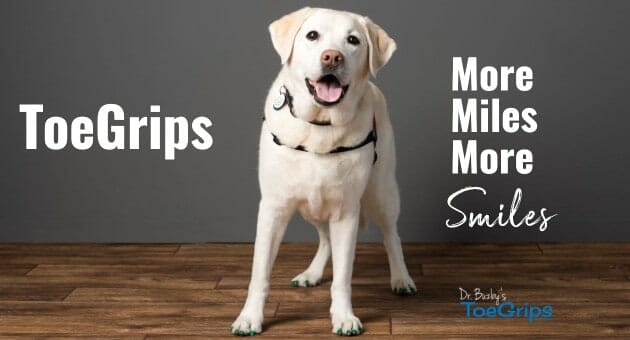
4. Purchase an assistive device to help get your dog up and moving.
There are many options for slings and harnesses that can make it easier for dog parents to help their dogs get up, walk, and navigate stairs. My favorite by far is the Help ‘Em Up harness. Conveniently, it’s designed to be comfortable (after an introduction process) for long-term wear. This means you don’t need to put it on and take it off every time you’re going to use it.
It has a piece that fastens around the chest, similar to a traditional harness. Plus, it has a piece that fastens around the hips. This connects by a strap to the chest piece, which helps keep it in place. Also, both halves of the harness have a handle. This is convenient for providing a bit of support or assistance to your dog.
Using the handles on the Help ‘Em Up harness is much easier than having to reach underneath your dog to help lift him or her up. Also, holding them can provide security when going up or down the stairs. Because of its design, the harness stays in place securely and is easy to use. It’s also machine washable, which is very helpful for older dogs who may occasionally experience urine leakage.
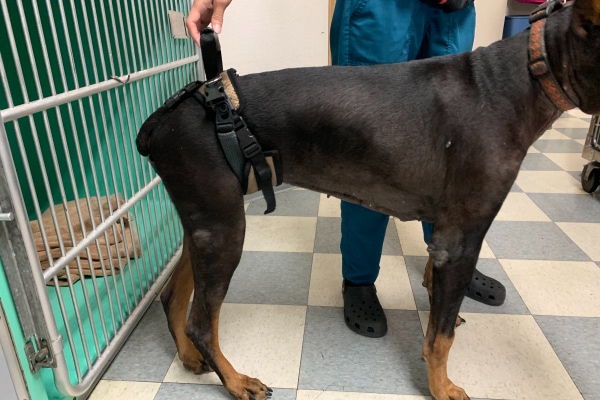
5. Start your dog on a joint-health-boosting nutraceutical.
There are a variety of joint supplements for dogs that can help improve joint health. For example, the omega-3 fatty acids for dogs found in fish oil have been shown in several studies to reduce inflammation in general and to improve clinical signs of arthritis. They are also beneficial for several other body systems, including the skin, kidneys, and brain. For these reasons, omega-3 fatty acids are my favorite all-purpose supplement.
Other common supplements for joint health in dogs include:
- Glucosamine and chondroitin
- Green lipped mussel extract
- Egg shell membrane protein
- Deer antler velvet
A great product that combines the benefits of green lipped mussel for dogs and deer antler velvet is Dr. Buzby’s Encore Mobility™ hip and joint supplement. It does a wonderful job of reducing inflammation because it is rich in omega-3s. Plus, it is chock full of excellent joint-support ingredients, as shown in the image below.
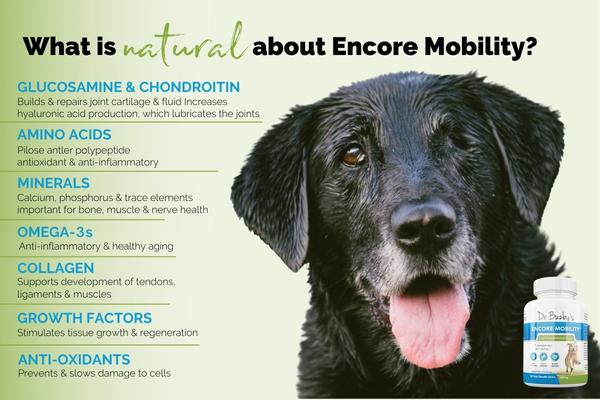
6. Consider using a joint fluid modifier like Adequan®.
Adequan for dogs is a polysulfated glycosaminoglycan (PSGAG) that your vet can administer as an injection. While it is labeled for intramuscular injection, studies suggest it can be equally effective when injected under the skin.
Adequan appears to:
- Decrease inflammation in arthritic joints
- Reduce the levels of cartilage-damaging enzymes inside joints
- Improve the quality of joint fluid
While not actually labeled for pain relief, I have seen many patients experience significantly improved comfort and mobility with consistent Adequan injections.
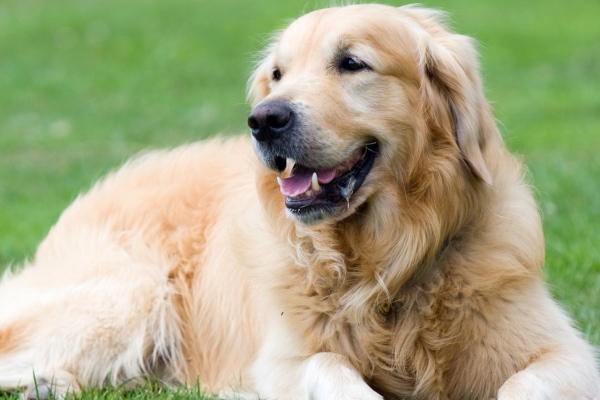
7. Ask your vet about pain medications.
These options, plus other methods of natural pain relief for dogs can be an excellent place to start. However, some dogs with hip dysplasia may need prescription-strength pain relief too. There are a variety of pain and anti-inflammatory medications that be beneficial in reducing pain. Some helpful medications your vet might prescribe to relieve your dog’s arthritis pain include:
- Gabapentin for dogs
- Amantadine for dogs
- Tramadol for dogs
- NSAIDs such as Rimadyl® and Galliprant®
Please talk with your veterinarian if you feel your dog needs more pain relief. With the variety of options available, there should be one that works for your dog.
What about surgery?
These seven medical treatment options are great for some dogs. But for other dogs with hip dysplasia, surgery ends up being the best treatment.
For young dogs with severe hip dysplasia, the goal of surgery is to prevent the onset of arthritis. In these pups, the most common procedures are:
- Triple pelvic osteotomy (TPO)
- Femoral head osteotomy (FHO)
- Juvenile pubic symphysiodesis (JPS).
In older dogs who have already developed arthritis due to hip dysplasia, veterinary surgeons most often use a FHO or total hip replacement for dogs to relieve severe arthritis pain.
What is the outlook for dogs with hip dysplasia?
There are some great options for managing hip dysplasia and giving affected dogs a good quality of life. And as you learned earlier, dogs with hip dysplasia can live a long and happy life. However, eventually there may come a time when it is very difficult to keep them comfortable and mobile. This is especially the case for dogs with severe hip dysplasia or end-stage hip dysplasia.
If you worry that your dog’s quality of life may be declining, there are a few things you can do to help gain some clarity.
Talking with your veterinarian is a great place to start. He or she can examine your dog and review the current management plan. This allows your vet to brainstorm ways to improve your dog’s quality of life. Sometimes there are things you can do that will make a significant difference for your dog. But even if there aren’t, it is helpful to know you have done everything you can.
The other thing your vet can do is give you his or her honest assessment of your dog’s quality of life. And he or she can can teach you how to monitor your dog’s quality of life at home.

Ways to evaluate quality of life
One way to do this is to start keeping a diary of your dog’s good days and bad days. Often we’ll see a pattern start to emerge over time. The good days may become fewer and further apart, and the bad days become more common. This method is helpful because when you live with your dog every day, you may not notice gradual changes in his or her quality of life. Having things written down can help you spot patterns and trends that you may not notice on your own.
You could also consider using a quality of life scale for dogs. These are tools that ask you to evaluate your dog in various categories such as attitude, eating, sleeping, movement, etc. Based on your answers, you can get an idea of your dog’s quality of life. Plus, if you use the same scale regularly, you can watch for trends that might indicate a decline in quality of life.
Finally, it can be helpful to ask the opinions of trusted friends or family members. Pick someone who knows your dog and is willing to be gentle but honest with you. Talk with them about your concerns and ask how your dog seems to them. Since they don’t see your dog daily, it may be easier for them to compare your dog’s current quality of life to the way it was a few weeks or months ago.
Signs your dog is declining
I can’t speak for every dog and every situation. But from experience I can say that in general, uncontrolled pain and poor mobility tend to be the two factors that lead to a dog with hip dysplasia being euthanized.
When your dog is in pain every day, and you have exhausted all the pain-control options, it may be time to make the difficult decision to let him or her go. Or when dogs can no longer move themselves around their home to get to their food and water, look out the window, investigate a noise they hear outside, or even do something as simple as shift from one side to the other in bed, the most compassionate thing might be to help them leave their failing body.
For these dogs in end-stage hip dysplasia, I believe that euthanasia is truly the last kind thing we can do for them. We can give them a peaceful end to their life, usually held by the person who loves them the most, and spare them from any further pain or suffering.
Seeing euthanasia as a kindness
The decision to euthanize is probably the hardest one we’ll ever make for our canine companions. We want to have as much time with them as possible. And even a very elderly dog’s life always seems much too short.
I’ve been privileged to be a part of the decision-making process for many families. And I’m always comforted by the amount of thought and care that goes into deciding to euthanized their dear dog.
When we love a dog, we want him or her to be happy, safe, and comfortable for however much time he or she has with us. All of the decisions we make are made with our dog’s best interests in mind. This decision is no different.
When our beloved dogs no longer have the quality of life we want for them, and we can’t do any more to help improve it, euthanasia can spare them from any further suffering. It can give them a painless and peaceful end to their life surrounded by the ones they love. It is truly the last kind and loving thing we can do for our beloved dogs.
If you are finding yourself facing that difficult decision, these resources may be a comfort to you:
- In-Home Dog Euthanasia: Heartfelt Answers to 12 FAQs
- Preparing for Your Dog’s Euthanasia: 10 Thoughts for Peace
- Grieving the Loss of a Dog After Euthanasia (& Finding Peace)
- Dog Euthanasia: Knowing When to Say Goodbye
- How Will You Know When It’s Time to Euthanize Your Dog? 5 Caring, Heartfelt Messages
How well can a dog live with hip dysplasia?
Talk of euthanasia would be a rather sober note to end on, so I want to offer some hope and encouragement too. While the goal was to answer the question “How long can a dog live with hip dysplasia?”, I hope you also saw how well a dog can live despite having hip dysplasia. My patients Vera and Minnie are examples of that. And so are the many other dogs with hip dysplasia who are soaking up every moment of every day with joy and contentment.
Hip dysplasia doesn’t have to be a doom and gloom diagnosis. There are so very many methods of hip support for dogs. So if your dog does have hip dysplasia, please talk to your veterinarian about your options. It is often possible for your dog to live a happy, active, and long life with hip dysplasia!
What helped your dog with hip dysplasia keep living his or her best life?
Please comment below.


We welcome your comments and questions about senior dog care.
However, if you need medical advice, diagnosis, or treatment, please contact your local veterinarian.